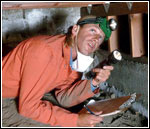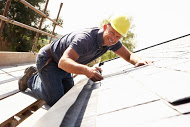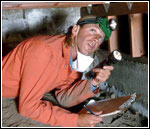If you are asking the question, then the answer should probably be, yes. No one should ever advise you not to get a home inspected. If you do decide to go ahead, make sure the home inspector has experience, training and a broad understanding of home construction and all the bits and pieces that make a house whole. This advice holds true whether you are looking to buy a Spruce Grove or Stony Plain home, a Parkland County acreage, or property in the Edmonton region or elsewhere.
 A good home inspector will spend between 2 to 4 hours (depending on the house size) inspecting the home. He or she should have equipment such as a moisture detector, carbon monoxide detector, ladders, magnifying glasses, mirrors and other specialized equipment in order to check all areas of the home and in cracks and crannies when needed. A thorough home inspection should give you a good overview of the general condition of the plumbing, electrical, roofing, insulation, windows, grading, drainage, the foundation where exposed, furnace, hot water tank, and general construction and condition of the home. It is advised that you be there for most of the inspection or at least the latter half of the inspection. That way you can see firsthand any deficiencies (minor or major) noted by the inspector. You can also ask the inspector to look more closely at any areas that are of concern to you.
A good home inspector will spend between 2 to 4 hours (depending on the house size) inspecting the home. He or she should have equipment such as a moisture detector, carbon monoxide detector, ladders, magnifying glasses, mirrors and other specialized equipment in order to check all areas of the home and in cracks and crannies when needed. A thorough home inspection should give you a good overview of the general condition of the plumbing, electrical, roofing, insulation, windows, grading, drainage, the foundation where exposed, furnace, hot water tank, and general construction and condition of the home. It is advised that you be there for most of the inspection or at least the latter half of the inspection. That way you can see firsthand any deficiencies (minor or major) noted by the inspector. You can also ask the inspector to look more closely at any areas that are of concern to you.
At the end of the inspection the home inspector should provide you with a report outlining his observations. He or she should also give you an overall view of the condition of the home (i.e. sub-standard, normal, above average), and recommend maintenance that should be done over time.
A house put under a magnifying glass like this will create a list of observations. That list can sometimes seem overwhelming. Don’t be surprised when your home inspector refers to a 25-year-old furnace as being “fully depreciated”. That doesn’t mean the furnace has to be replaced tomorrow. If it is operating safely, it could last, with proper maintenance, another 5 or more years. But a 25-year-old furnace is only about 60% efficient (60% of the fuel used by the furnace is used to produce heat and the other 40% goes up the chimney). Most people nowadays replace furnaces in order to have a more efficient furnace. The building code now requires that all new furnaces be high efficiency (90 plus percent). The home inspection needs to be put into perspective. It should reflect, within reason, what you viewed and bargained for when you negotiated your purchase.
Although a home inspection can be used to try to re-negotiate the original purchase contract or to try to get the seller to do repairs or upgrading, this is usually the exception to the rule, reserved for bigger ticket items that a buyer would not have expected from the original viewing of the home. Things that fall into this category could include safety issues (for example, a cracked heat exchanger on a furnace), a structural issue that you were not aware of, or such a very large list of minor deficiencies that it now represents a major expense, with the exception of a home that was known to require a lot of work, such as a “handyman special”. There is no one answer that fits all situations, so it is always best to discuss any concerns you have with your REALTOR®.
See also “How to Pass Your Home Inspection” on BarryT.ca.
Comments or questions are always welcome! Contact me here, phone me at 780-910-9669 or email me at barry@barryt.ca.








 For more information on this topic within my website:
For more information on this topic within my website: A good home inspector will spend between 2 to 4 hours (depending on the house size) inspecting the home. He or she should have equipment such as a moisture detector, carbon monoxide detector, ladders, magnifying glasses, mirrors and other specialized equipment in order to check all areas of the home and in cracks and crannies when needed. A thorough home inspection should give you a good overview of the general condition of the plumbing, electrical, roofing, insulation, windows, grading, drainage, the foundation where exposed, furnace, hot water tank, and general construction and condition of the home. It is advised that you be there for most of the inspection or at least the latter half of the inspection. That way you can see firsthand any deficiencies (minor or major) noted by the inspector. You can also ask the inspector to look more closely at any areas that are of concern to you.
A good home inspector will spend between 2 to 4 hours (depending on the house size) inspecting the home. He or she should have equipment such as a moisture detector, carbon monoxide detector, ladders, magnifying glasses, mirrors and other specialized equipment in order to check all areas of the home and in cracks and crannies when needed. A thorough home inspection should give you a good overview of the general condition of the plumbing, electrical, roofing, insulation, windows, grading, drainage, the foundation where exposed, furnace, hot water tank, and general construction and condition of the home. It is advised that you be there for most of the inspection or at least the latter half of the inspection. That way you can see firsthand any deficiencies (minor or major) noted by the inspector. You can also ask the inspector to look more closely at any areas that are of concern to you.